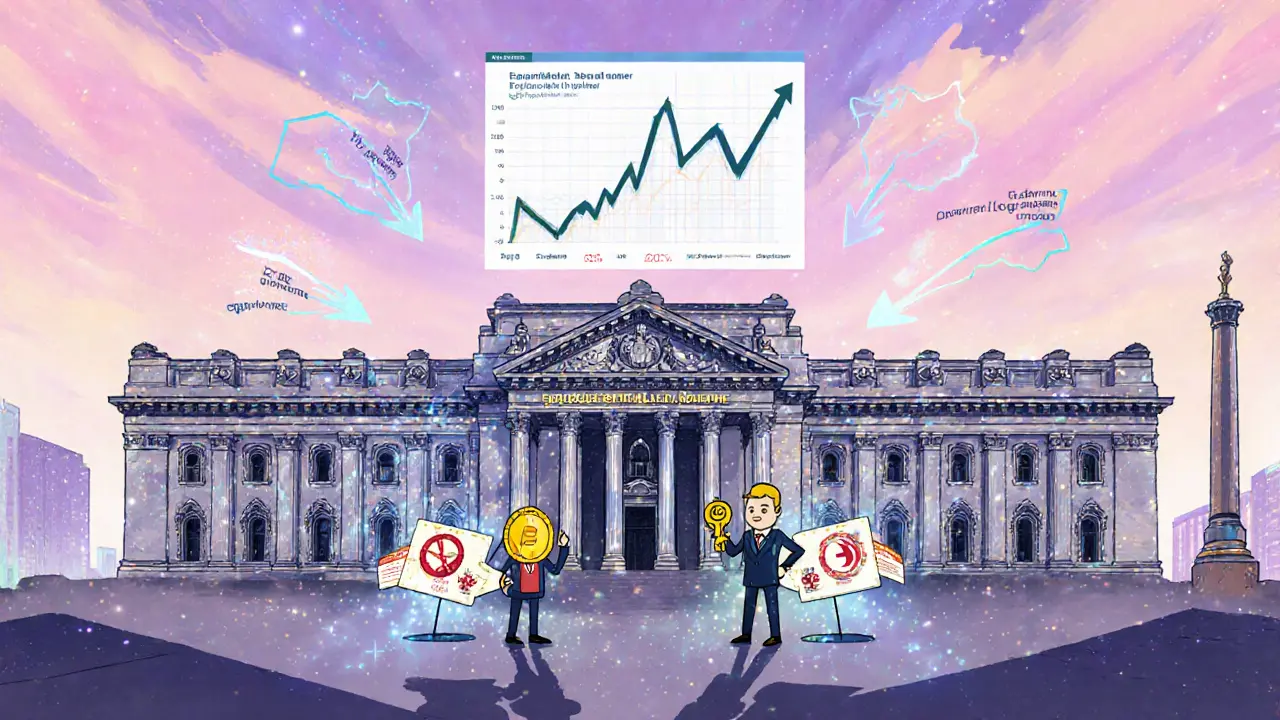Russia Crypto Adoption Calculator
Crypto Holders (Millions)
0
Estimated based on current trends
Bitcoin Hashrate Share (%)
0
Based on mining efficiency
Estimated Market Revenue (2025)
$0 billion
Projected based on adoption and regulatory factors
Russia is fast becoming one of the hottest spots for digital money, sitting at rank10 on the Chainalysis 2025 Global Cryptocurrency Adoption Index. After years of sanctions, a shaky ruble and a tech‑savvy population, more than 17million Russians now hold crypto, mining farms control 16% of Bitcoin’s hashpower and major banks are dipping their toes into regulated platforms. If you’re wondering why this matters, how it works and what’s coming next, keep reading - the picture is clearer than you think.
TL;DR
- Russia ranks 10th globally for crypto adoption, with 17million holders in 2025.
- Crypto revenue is projected at $2.3billion, up 68% YoY.
- Bitcoin mining contributes 16% of global hashpower, thanks to cheap electricity.
- The Central Bank’s experimental legal regime (ELR) enables regulated institutional services.
- Retail cash‑crypto trades face possible bans, creating a dual‑track market.
Why Russia’s Crypto Surge Isn’t a Fluke
When you hear about crypto in a sanctioned economy, the first thought is “just a loophole”. In Russia’s case, the adoption rate of Cryptocurrency is a digital asset that can be transferred without relying on traditional banks is 0.14 on the Global Crypto Adoption Index - almost on par with China despite far stricter rules. The driver? A mix of economic anxiety and strategic necessity.
Ruble devaluation has eroded savings, prompting people to hedge with crypto. At the same time, sanctions choke cross‑border payments, so businesses turn to crypto‑enabled trade routes, especially for oil shipments to India and other non‑Western partners. The result is a market that’s both a safety net and a growth engine.
Mining Might: Russia’s Share of Bitcoin’s Hashrate
One of the biggest surprises is how much of the Bitcoin network sits in Russia. According to the River Bitcoin Adoption Report 2025, Russian miners control 16% of global hashpower, second only to the United States. This is not a fluke - the country’s vast cold climate reduces cooling costs, and electricity rates hover around $0.03/kWh in many regions, far below the global average.
Mining firms have set up large‑scale farms in Siberia and the Urals, often partnering with local energy providers. This infrastructure not only cements Russia’s role in Bitcoin’s security but also feeds into a growing blockchain‑infrastructure sector that could attract foreign capital once regulatory clarity improves.
Regulatory Landscape: The Experimental Legal Regime (ELR)
In March 2025, the government rolled out the Experimental Legal Regime (a framework that allows licensed institutions to offer crypto services under supervision. The Central Bank of Russia launched a state‑backed exchange platform under this regime, aimed at high‑net‑worth individuals and corporations.
Major banks such as Sberbank (Russia’s largest commercial bank and VTB (a leading state‑controlled bank have rolled out crypto‑custody services, signaling growing institutional confidence. However, lawmakers are also pushing a ban on cash‑based crypto transactions, a move that could shrink liquidity for everyday users.

How People Use Crypto in Russia Today
Russian crypto users are far from hobbyists. Data shows heavy involvement across three main fronts:
- Hedging against inflation: Stablecoins like USDT and USDC are popular for preserving purchasing power.
- Cross‑border trade: Companies use crypto to settle invoices with partners in India, China, and the Middle East, bypassing SWIFT.
- DeFi participation: Yield farms, liquidity pools and decentralized exchanges attract both retail and institutional capital.
Mobile wallets are a major entry point - Russia contributed a large slice of the 982million global crypto‑wallet installations recorded in 2025. Most users access their assets via smartphones, often combining exchange apps with DeFi dashboards.
Economic Impact: Numbers That Matter
Let’s put the hype into hard figures. The Russian crypto market is projected to generate $2.3billion in 2025, a whopping 68.45% annual growth rate. Exchange traffic places Russia in the top‑five globally, alongside the United States, India, Brazil and Turkey.
| Country | Adoption Index | Crypto Holders (millions) | Annual Revenue (USDbn) | Bitcoin Hashrate Share |
|---|---|---|---|---|
| Russia | 0.14 | 17 | 2.3 | 16% |
| United States | 0.19 | 30 | 5.1 | 38% |
| China | 0.13 | 15 | 1.9 | 5% |
| India | 0.12 | 12 | 1.4 | 4% |
| Brazil | 0.11 | 8 | 0.9 | 2% |
These numbers show that Russia punches well above its weight, especially in mining power and institutional rollout.
Opportunities and Risks for Investors
If you’re eyeing Russia’s crypto space, there are clear entry points:
- Mining equipment manufacturers: With hashpower growing, demand for ASICs and efficient cooling solutions is rising.
- Blockchain infrastructure providers: Companies that offer node‑hosting, compliance tools and AI‑driven monitoring can tap into the ELR‑supported ecosystem.
- Stablecoin liquidity pools: As users hedge against inflation, providing deep USDT/USDC markets can be lucrative.
- Cross‑border payment gateways: Platforms that facilitate crypto‑to‑fiat conversions for trade partners will find a ready market.
But tread carefully. Regulatory volatility remains high - the proposed cash‑crypto ban could restrict retail flow, and Sanctions‑related legal actions could affect foreign investors. Moreover, geopolitical tensions can cause sudden swings in ruble‑denominated crypto pricing.
What’s Next? 2026 Outlook
Analysts expect the adoption curve to stay steep through 2026. AI‑enhanced transaction monitoring will likely make the ELR safer for institutions, encouraging more banks to join the crypto‑custody race. Meanwhile, Russia may negotiate crypto‑friendly trade agreements with non‑Western economies, expanding the use‑case beyond hedging to genuine commercial finance.
However, if the cash‑transaction ban passes, retail volumes could dip, pushing users toward centralized exchanges or offshore solutions. The tension between institutional openness and retail restriction will define the market’s shape.
Key Takeaways
- Russia is a top‑5 player in exchange traffic and the second‑largest Bitcoin miner worldwide.
- 17million people hold crypto, driven by ruble instability and sanctions avoidance.
- The Central Bank’s ELR offers a regulated gateway for institutions, while retail cash trades face possible bans.
- Stablecoins and DeFi are the primary tools for hedging and international trade.
- Investment prospects are strong in mining, infrastructure, and crypto‑payment services, but regulatory risk is high.

Frequently Asked Questions
How many Russians own cryptocurrency?
By the end of 2025, about 17million people in Russia - roughly 12% of the adult population - reported holding at least one digital asset.
What percentage of Bitcoin’s hashpower comes from Russia?
Russia contributes roughly 16% of the global Bitcoin hashrate, making it the second‑largest miner after the United States.
Is crypto trading legal for retail users in Russia?
Retail trading on exchanges is allowed, but the government is considering a ban on cash‑based crypto transactions, which could limit how users move funds in and out of the crypto ecosystem.
Which Russian banks offer crypto services?
Both Sberbank and VTB have launched crypto‑custody and trading platforms under the experimental legal regime.
What are the biggest investment opportunities in Russia’s crypto market?
Key areas include mining equipment and farm expansion, blockchain infrastructure services, stablecoin liquidity provision, and cross‑border crypto payment gateways that serve non‑Western trade partners.


Comments
april harper
When you stare at the raw numbers, the adoption curve feels like a slow sunrise over a frozen plain. The Russian populace, weary of inflation, begins to see crypto as a warm blanket against economic chill. Yet the very regulators who could light that fire also hold the matches with trembling hands. In that tension, a new kind of financial resilience might be forged. It’s a dance of hope and caution, performed in the shadows of a sprawling nation.
December 27, 2024 AT 12:46
Clint Barnett
The landscape of crypto in Russia by 2025 reads like a kaleidoscope of ambition, policy, and raw human desire for financial freedom.
First, the demographic surge of tech‑savvy millennials fuels a grassroots demand that cannot be ignored.
Second, the lingering sting of hyperinflation pushes everyday citizens to explore alternatives that preserve purchasing power.
Third, the government's regulatory score, hovering around a cautious six, signals a tentative embrace rather than outright endorsement.
Fourth, the sheer scale of the nation's electricity grid, priced at a modest cent per kilowatt‑hour, makes mining operations tantalizingly profitable.
Fifth, international sanctions have inadvertently nurtured a climate where decentralized assets appear as safe harbors.
Sixth, the cultural heritage of self‑reliance dovetails neatly with the ethos of decentralized finance.
Seventh, domestic exchanges are sprouting like mushrooms after a rain, offering localized liquidity.
Eighth, the educational push from universities introduces blockchain concepts to classrooms, planting seeds for tomorrow's innovators.
Ninth, the media narrative oscillates between hype and skepticism, creating a balanced but volatile public perception.
Tenth, venture capital flows from neighboring fintech hubs begin to trickle into Russian startups, fueling a subtle yet steady acceleration.
Eleventh, the emergence of community‑run mining pools democratizes access to hashpower, eroding the monopoly of large farms.
Twelfth, regulatory clarity on taxation, though still evolving, provides a framework that encourages compliant participation.
Thirteenth, the growing popularity of stablecoins anchored to the ruble offers a bridge between traditional finance and crypto.
Fourteenth, cross‑border remittance corridors powered by blockchain reduce fees dramatically, appealing to a diaspora hungry for connection.
Fifteenth, the convergence of DeFi protocols with local banking infrastructure hints at a hybrid future where old and new coexist.
Sixteenth, all these threads weave together into a tapestry that suggests Russia's crypto adoption in 2025 will be neither a flash in the pan nor a half‑hearted experiment, but a measured evolution shaped by necessity, innovation, and a touch of audacity.
December 31, 2024 AT 17:34
Jacob Anderson
Oh great, Russia finally decided to hop on the crypto bandwagon like it’s the latest fashion trend.
January 4, 2025 AT 22:22
Kate Nicholls
While the calculator offers a slick visual, the underlying assumptions simplify a complex reality. Inflation, electricity costs, and regulatory scores interact in non‑linear ways that a single slider cannot capture. Moreover, regional disparities within Russia mean that adoption will vary wildly from Moscow to Siberia. A more nuanced model would incorporate user‑level data and geopolitical influences.
January 9, 2025 AT 03:10
Carl Robertson
The drama of Russia’s crypto saga feels like a high‑stakes thriller where every policy change is a plot twist. On one hand, the state’s tentative legal framework tempts innovators; on the other, the looming threat of crackdowns casts a long shadow. It’s a love‑hate relationship that fuels both bold ventures and cautious retreats. The stakes are as high as the hash rate, and the audience watches with bated breath.
January 13, 2025 AT 07:58
Rajini N
For anyone trying to make sense of the adoption calculator, start by feeding realistic inputs: use the latest population estimate, the current inflation rate from the Central Bank, and the average industrial electricity price reported by Rosstat. Adjust the regulatory score based on recent legislative moves-if new crypto‑friendly bills have passed, bump it up a point or two. Remember that the holder estimate grows faster when inflation spikes, reflecting a flight to alternative stores of value. Finally, compare the hash‑power share with global data to gauge Russia’s mining competitiveness.
January 17, 2025 AT 12:46
Jan B.
Got it, thanks for the clear steps. This will make my own projections a lot smoother.
January 21, 2025 AT 17:34
MARLIN RIVERA
The only drama here is the self‑inflicted hype; numbers don’t lie, policy does.
January 25, 2025 AT 22:22
Debby Haime
Exciting times ahead! If the community rallies around education and infrastructure, Russia could become a crypto powerhouse. Let’s keep the momentum going and spread the word.
January 30, 2025 AT 03:10
emmanuel omari
Russia’s vast resources and technical talent give it a natural edge; foreign critics fail to see the strategic depth of a nation that can harness its own energy for mining. Domestic innovation will outpace any external pressure, proving once again the resilience of the motherland.
February 3, 2025 AT 07:58
Andy Cox
Looks like the numbers are moving up slowly but steady it’s interesting to watch how policy shifts impact adoption
February 7, 2025 AT 12:46
Courtney Winq-Microblading
The essence of crypto adoption in Russia mirrors a broader existential quest for autonomy in a world of centralized control. When citizens grapple with inflation, they are, in effect, reasserting their agency over personal wealth. This subtle rebellion is encoded in the blockchain’s immutable ledger, a digital testament to freedom. The calculator, then, is not just a tool but a reflective surface for societal aspirations.
February 11, 2025 AT 17:34
katie littlewood
Seeing the adoption metrics rise is like watching a sunrise over the Siberian tundra, each ray representing a new user discovering the promise of decentralized finance. The interplay between affordable electricity and a regulatory environment that is gradually warming up creates fertile soil for mining farms to take root. Moreover, as more Russians become comfortable with digital wallets, everyday transactions-whether buying a cup of tea in St. Petersburg or paying for a train ticket from Vladivostok-gain a layer of speed and security that was previously unimaginable. This cascade effect not only empowers individuals but also stimulates ancillary services, from crypto‑focused legal counsel to innovative fintech startups. The ripple extends beyond borders, inviting foreign investors to partake in a market that is both vast and surprisingly agile. In this evolving landscape, community education remains the cornerstone, ensuring that the hype does not outstrip the understanding needed for sustainable growth. Ultimately, the 2025 outlook is bright, provided that optimism is tempered with diligent infrastructure development and thoughtful regulation.
February 15, 2025 AT 22:22
Jenae Lawler
While prevailing discourse celebrates the burgeoning crypto sector in Russia as an unequivocal boon, it is incumbent upon the discerning analyst to interrogate the underlying premises. The presumption that inexpensive electricity translates automatically into sustainable mining disregards the volatility of energy markets and potential regulatory arbitrage. Furthermore, the notion that a regulatory score of six signifies a conducive environment conflates mere tolerance with active endorsement. One must also consider the geopolitical ramifications of a state‑sanctioned crypto expansion, which may provoke international countermeasures detrimental to long‑term viability. Hence, the optimist’s narrative, though compelling, warrants a measured skepticism lest we overlook systemic vulnerabilities.
February 20, 2025 AT 03:10
Chad Fraser
Yo, the numbers are looking solid-let’s keep the chat rolling and share tips on building safe wallets! Crypto in Russia is getting real, so stay sharp and have fun.
February 24, 2025 AT 07:58
Kate Roberge
Interesting take, but the kaleidoscope you describe might be glossing over the fact that policy can shift overnight, turning today’s optimism into tomorrow’s regret. A splash of caution wouldn’t hurt the colorful picture.
February 28, 2025 AT 12:46